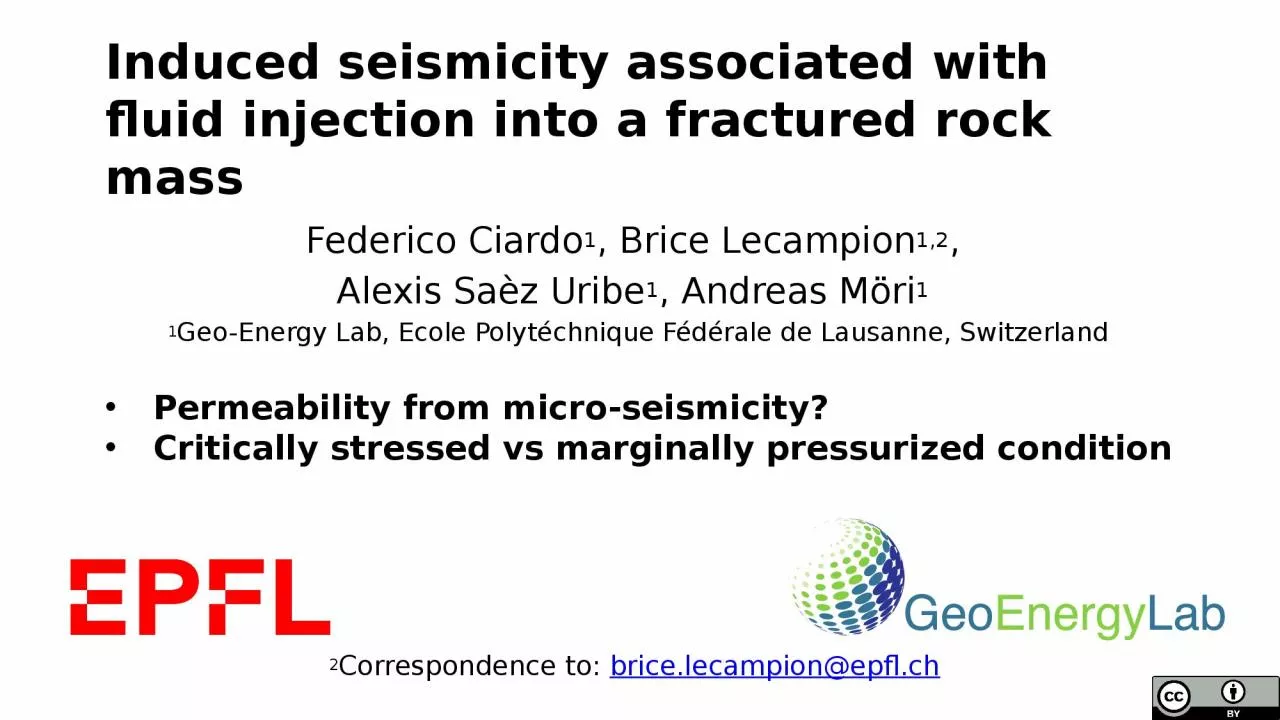

Federico Ciardo 1 Brice Lecampion 12 Alexis Saèz Uribe 1 Andreas Möri 1 1 GeoEnergy Lab Ecole Polytéchnique Fédérale de Lausanne Switzerland 2 Correspondence to ID: 1019340
Download Presentation The PPT/PDF document "Induced seismicity associated with fluid..." is the property of its rightful owner. Permission is granted to download and print the materials on this web site for personal, non-commercial use only, and to display it on your personal computer provided you do not modify the materials and that you retain all copyright notices contained in the materials. By downloading content from our website, you accept the terms of this agreement.
1. Induced seismicity associated with fluid injection into a fractured rock mass Federico Ciardo1, Brice Lecampion1,2, Alexis Saèz Uribe1, Andreas Möri1 1Geo-Energy Lab, Ecole Polytéchnique Fédérale de Lausanne, Switzerland2Correspondence to: brice.lecampion@epfl.ch Permeability from micro-seismicity?Critically stressed vs marginally pressurized condition
2. Marginally pressurized condition Friction coefficientEffective stress anisotropy ratioNormalized injection over-pressureStress criticality ratioOver-pressure evolution Aseismic slipping patch evolution
3. Critically stressed condition Friction coefficientEffective stress anisotropy ratioNormalized injection over-pressureStress criticality ratioOver-pressure evolution Aseismic slipping patch evolution
4. Observations & Concluding pointsOne governing dimensionless parameter, similar to Bhattacharya & Viesca (2019).In a critically stressed DFN the aseismic front is much faster than fluid diffusion within pre-existing fractures. Percolation value and injection over-pressure do not affect considerably the fast slipping patch growth (stress-interactions are dominant).The driving and triggering force of (micro-)seismic events thus corresponds to the fast aseismic slipping patch propagation and NOT to the pore-pressure front.This can explain the reason why the inferred permeabilities from the evolution of (micro-)seismicity over-estimate values obtained from pumping tests.On the other hand, in a marginally pressurized DFN the aseismic slip propagation is directly affected by pore-pressure diffusion.The corresponding percolation parameter plays an important role. Low percolation values may lead to fluid localization and thus restricted aseismic slipping patches. Our 2D HM numerical solver allows to simulate accurately problems of fluid injection in fractured rock masses, involving large number of fractures and intersections.It includes a family of solutions!
5. Induced seismicity associated with fluid injection into a fractured rock mass Federico Ciardo1,2, Brice Lecampion1, Alexis Saèz Uribe1, Andreas Möri1 1Geo-Energy Lab, Ecole Polytéchnique Fédérale de Lausanne, Switzerland2Correspondence to: federico.ciardo@epfl.chAdditional information: Numerical solver & Bibliography
6. ElasticityBoundary integral elasticity equations (quasi-static formulation):Plane strain conditionInfinite or finite domain Homogeneous, isotropic and linear elastic Impermeable medium
7. Constitutive relations for Displacement Discontinuity segmentsRigid-plastic like constitutive relation
8. Shear & tensile failure Shear failure (inadmissible region 2) - non-associated flow rule:Tensile failure (inadmissible region 1) - controlled by the value of the effective normal traction with the additional constraint of non inter-penetrability
9. Fluid flow in fracturesConservation of massAveraging it across the fracture width Allowing for a slightly compressible fluid of compressibility width averaged fluid velocityDarcy’s lawFluid compressibilityFluid viscosityFracture permeabilityIsothermal conditionsNewtonian fluidLaminar flowHydraulic diffusivity [L2T-1]
10. Numerical frameworkElasticity Displacement Discontinuity MethodPiecewise linear approximation No continuity at each intersecting mesh node Good accuracy even with non-uniform meshes Fluid flow Finite Volume MethodLinear and continuous approximationNode centered FV schemeIntrinsic local mass conservationNo need of structured mesh
11. Numerical schemeUpon discretization..Displacement discontinuity method for elasticity Finite volume method with fully implicit time integration scheme for fluid flow Pardiso direct solverGMRES iterative solverIt’s ill-conditioned Hierarchical approximation of fully populated elasticity matrix
12. PreconditionerUpper-triangular preconditioner matrix applied on right sidewithThe system of equations can thus be rewritten as
13. Preconditioner (cont’d.)We never want to compute the inverse of the Schur complement S, so we make a change of variable such that the system of equations 1 reduces to Let us have a look at the spectral properties of the matrix of coefficient with and without application of preconditioner
14. Preconditioner (cont’d.)The preconditioned system of equations is solved via GMRES iterative method for the unknown vectors u1 and z2.Once the iterative solution converges within a given tolerance, the solution of the preconditioned mechanical problem is given by No need to solve iteratively 2 system of equations & no need to invert Schur complement!
15. BibliographyBhattacharya, P., & Viesca, R. C. (2019). Fluid-induced aseismic fault slip outpaces pore-fluid migration. Science, 364(6439), 464–468. F. Ciardo and B. Lecampion. Effect of dilatancy on the transition from aseismic to seismic slip due to fluid injection in a fault. Journal of Geophysical Research: Solid Earth, 124, 2019.